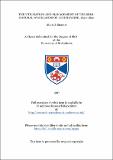Files in this item
The utilisation and management of the semi-natural woodlands of Lochtayside, 1650-1850
Item metadata
| dc.contributor.advisor | Smout, T. C. (T. Christopher) | |
| dc.contributor.advisor | Whittington, Graeme Walter | |
| dc.contributor.author | Stewart, Mairi J. | |
| dc.coverage.spatial | 150 p. 3 p. of plates | en_US |
| dc.date.accessioned | 2018-05-28T09:41:00Z | |
| dc.date.available | 2018-05-28T09:41:00Z | |
| dc.date.issued | 1997-06 | |
| dc.identifier.uri | https://hdl.handle.net/10023/13559 | |
| dc.description.abstract | There has been in Scotland, in recent years, a resurgence in interest the past history of our woodland, and their future management. The work of Lindsay in the 1970's did much to scotch earlier misconceptions about the utilisation and management of Highland woodlands (Lindsay 1974). Rather than being wholly exploitative, commercial influences during the 18th and 19th centuries may, in fact, have helped temper further woodland decline. It is now generally recognised that non-commercial influences may have been more significant in the evolution of woodlands in the historic period. It is now generally recognised that an understanding of past influences can contribute to future management strategies. This thesis therefore set out to examine the utilisation and management of the semi-natural woodlands of Lochtayside, and in particular, the commercial and non-commercial uses of the woodlands, and their subsequent management. It is hoped that results of this study would both suppliment our existing understanding of Scottish woodland history, and be taken into consideration in the debate on future management strategies. Initially, the study provides a context for the processes of woodland utilistion and management. Thus, the principal decisionmakers involved in the determination of woodland policies on Lochtayside were examined: the Campbells of Glenorchy. Both internal and external factors which might affect their decisions were also investigated. A critical evaluation of the sources for a woodland history study followed. Sources included, contemporary published works relating to the Highland rural society and the economy; the primary documentary source, i.e., the Breadalbane muniments; and cartographic sources, primarily, the Pont Map, the Roy Map, both the Fair and the Protracted versions, the 1769 Survey of Lochtayside and the 1st edition Ordnance Survey. A critical assessment of the advantages and disadvantages is regarded as fundamental to woodland history, and the study explored the limitations of using such sources, in particular the cartographic evidence. Finally, the non-commercial use of the produce and area of the semi-natural woodlands on Lochtayside, and the commercial use of these woodlands, including for bark, timber and charcoal was examined. Conclusions reached suggest there was a complex relationship between these two forms of use which affected the management of the woodlands, and ultimately the extent and composition of the woodlands on Lochtayside. It became clear that the relationship between the agriculture and woodlands was critical. The precise nature of this relationship, however, requires further examination. | en_US |
| dc.language.iso | en | en_US |
| dc.publisher | University of St Andrews | |
| dc.subject.lcc | SD183.S8 | |
| dc.subject.lcsh | Forests and forestry--Scotland--History | |
| dc.title | The utilisation and management of the semi-natural woodlands of Lochtayside, 1650-1850 | en_US |
| dc.type | Thesis | en_US |
| dc.contributor.sponsor | Scottish Native Woods | en_US |
| dc.type.qualificationlevel | Doctoral | en_US |
| dc.type.qualificationname | PhD Doctor of Philosophy | en_US |
| dc.publisher.institution | The University of St Andrews | en_US |
This item appears in the following Collection(s)
Items in the St Andrews Research Repository are protected by copyright, with all rights reserved, unless otherwise indicated.

